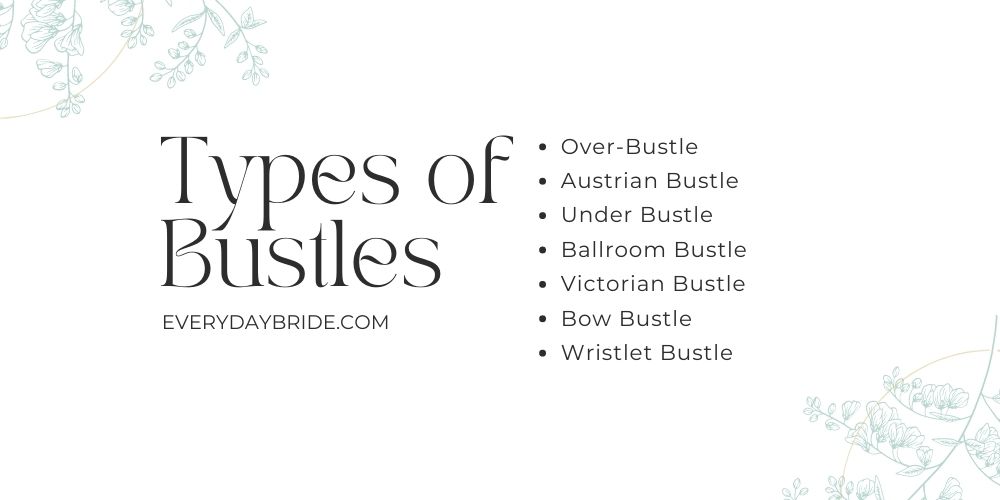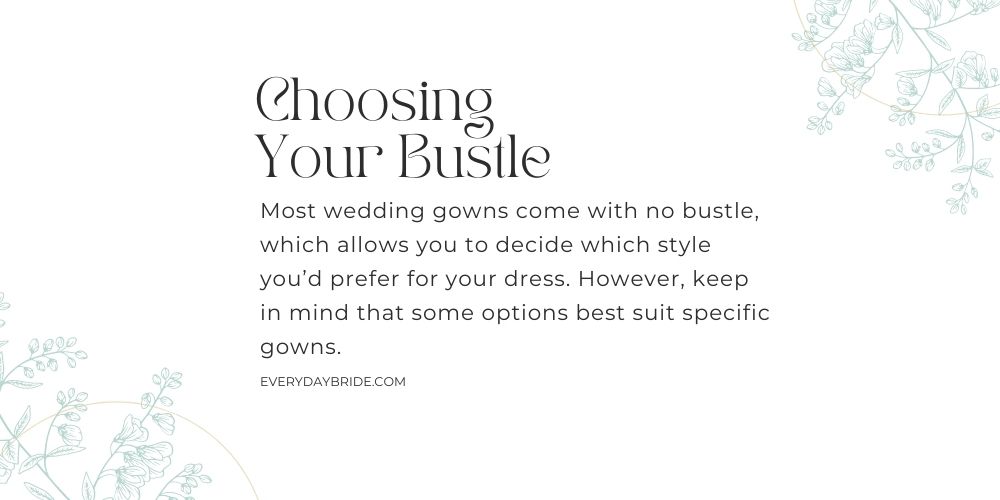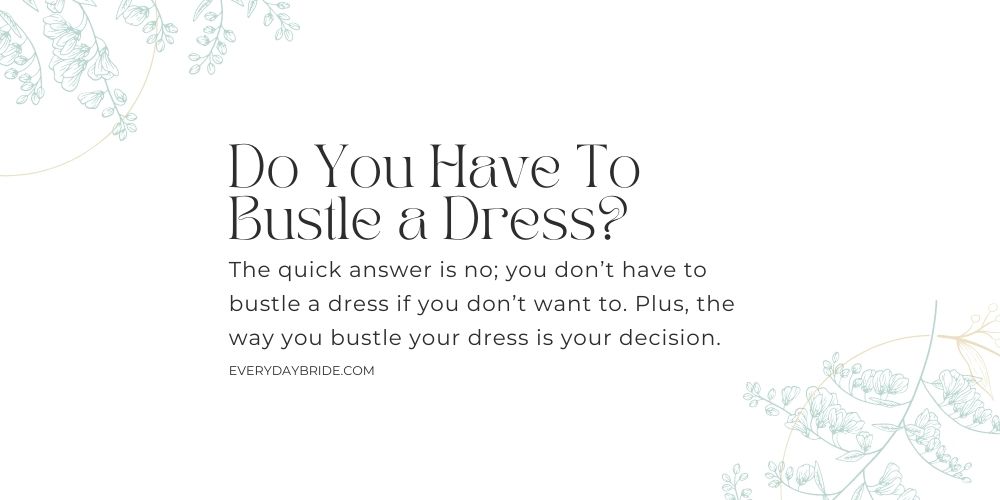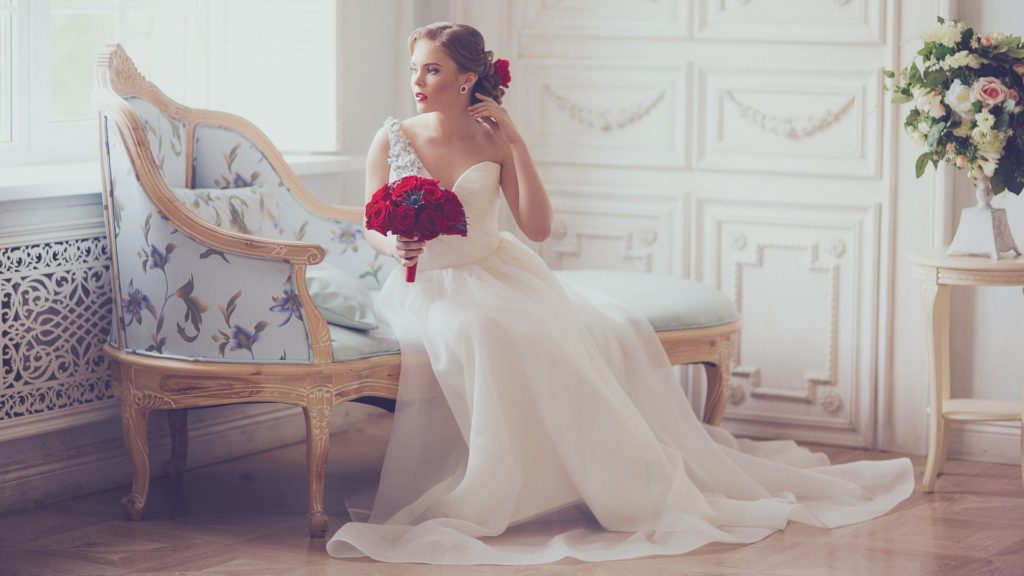In theory, buying a wedding dress is a simple task. You decide on a budget and gown styles, then have a blast trying on exquisite gowns. If only it were that easy. After deciding on a dress, you also need to consider the type of bustle you want for the train of your dress. This bridal guide will explain the different kinds of bridal gown bustles, so analyze your top options.
What Is a Bustle?
The bustle is a part of the dress, often in the back, that allows you to lift the train. Seamstresses add buttons, hooks, or ribbon so you can fasten the fabric once you bustle your dress. The bride does this with the help of a relative or bridesmaids after photos and the ceremony. Bustling is especially important if you have a long train. You or a guest could trip over the long fabric as you tear up the dance floor, and that’ll put a damper on things. Bustling prevents this so that you can party the night away.
Bridal Tip
Most of the time, the bride doesn’t bustle the dress herself, especially if the train requires multiple hooks or buttons for this. In most cases, her mother or a bridesmaid assists her. As you plan your wedding, consider who does what for each wedding role.

Types of Bustles
Similar to there being various types of wedding gowns, there are also variations in bustle style. Each option suits a different skirt style to keep the dress lying properly. The bustles we’ll discuss include the following:
- Over-Bustle
- Austrian Bustle
- Under Bustle
- Ballroom Bustle
- Victorian Bustle
- Bow Bustle
- Wristlet Bustle
Without any further ado, let’s get into these different types of bridal gown bustles, plus which dress styles they appear the most flattering with.
Over-Bustle
Some people also refer to the over-bustle as an American bustle. This option has hooks or buttons on the skirt so you can lift the dress when bustling. Sometimes, there are several hooks or buttons to create multiple layers that cascade downward.
The bustle folds over the dress, so you can see the folds, which adds drama to the dress. This creates an eye-catching gown when you enter the reception space. It’ll look as elegant as it did for your walk down the aisle. Over-bustles are ideal for ball gowns because all that fabric enhances the appearance of the folds.
Austrian Bustle
An Austrian bustle is an excellent alternative if you want to create a ruched appearance when bustling the train. In this design, a seamstress sews a drawstring into the dress so the bride can pull it up to create a drape after bustling her dress. Austrian bustles are best for ball gowns, A-line dresses, mermaid dresses, and highly detailed gowns.
Bridal Tip
This bustle type tends to be among the most expensive because creating it requires a lot of work. Additionally, Austrian bustles are best if you only plan to bustle your dress once that night.
Under Bustle
This is also called the French bustle and looks best on a gown that shows off your natural waistline. We recommend A-line and mermaid dresses for specific gown styles that look great with an under-bustle. With this style, the hooks or buttons are on the underside of the dress. You’ll then use ribbons attached to the inside of the dress to keep it in place. The under-bustle is ideal for creating an elegant yet understated look.
Ballroom Bustle
Despite the name, a ballroom bustle isn’t solely for ball gown dresses. You can use it on nearly any style of dress—A-line, sheath, mermaid—to lift the train. Because it’s hidden inside the dress, this bustle option is perfect if you have a floor-length dress but don’t love the appearance of a bustle.
Victorian Bustle
Also knowns as a royal bustle, this option creates an elegant look that gathers the fabric to make it appear ruched. There are various connection points to hook or button the dress for this vintage look. You’ll need help compiling and fastening the train to the back of the wedding dress. Victorian bustles are ideal for A-line dresses and ball gowns because they create a fuller skirt.
Bow Bustle
On a bow bustle, the dress folds drape down from the bodice. While this bustle works great for various dress styles, most dress designers recommend it for gowns with a statement piece on the back, such as a bow or sash. The dress train will connect at a hook or button under the bow on the gown to remain hidden.
Wristlet Bustle
A wristlet bustle has a loop on the bottom of the train that you’ll wear around your wrist to lift the skirt. This allows you to bustle your dress at your leisure throughout the night. A wristlet bustle is best for sheath and A-line gowns that use lightweight fabric. It won’t work for options such as ball gowns with several layers of tulle because they’ll be too heavy.

Choosing Your Bustle
Most wedding gowns come with no bustle, which allows you to decide which style you’d prefer for your dress. However, keep in mind that some options best suit specific gowns. The over-bustle is most popular for ball gowns and other styles that require a lot of material. When you try dresses on, ask the employee helping you if they can hold the areas of the dress to help you envision how certain styles may look.
Work With a Seamstress
If you want a specific bustle, talk with a seamstress or designer before you go dress shopping. One of these experts can help you choose the best wedding gown fabric. Certain options, such as wristlet dresses, won’t work with heavier materials like faille.
A designer or seamstress can also help you determine which dress and bustle style looks most flattering on your silhouette. Of course, on your big day, you want to wear a dress that appears made for you.
Consider Dress Budget
While all seamstresses charge different rates, creating specific bustles costs more money no matter who you hire. This is because options such as the Austrian bustle are complex, and making them is a major project. As a result, they come at a higher price because you need to compensate for time.
As you begin dress shopping, figure the price of your bustle and other alterations into the overall cost. In other words, if you have a dress budget of $1,100, don’t buy a dress that hits your limit after taxes. Adding the bustle and alternations will add several hundred dollars to the gown. In addition, overspending on the dress may force you to sacrifice in other areas of the wedding.

Do You Have To Bustle a Dress?
The quick answer is no; you don’t have to bustle a dress if you don’t want to. Plus, the way you bustle your dress is your decision. While options such as the over-bustle are great for ball gowns, you can decide on a wristlet bustle if it better fits your wedding vision. You may want to raise the dress train for some dancing but let it pool out for other parts of the night—a wristlet bustle makes this easy.
Ultimately, you decide whether you want a bustle and which type. As you consider your options, remember that some are best for specific dress styles and fabrics. Use this knowledge to help you find your dream bridal gown!


